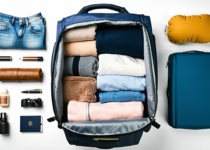Weekender Backpacks With Hidden Pockets For Secure Packing

We’ve all been there: digging through our bags, hoping to spot our passport or phone, only to wonder if someone else might reach it first. A hidden pocket backpack gives us peace of mind, letting us stow valuables out of sight and out of mind. In this guide, we’ll walk through why secret compartments matter, explore top weekender backpack styles, and share packing tips so you travel confidently with everything secured.
Hidden Pocket Benefits
Boosting Security
Imagine strolling through a crowded train station or local bazaar—knowing your credit cards, cash, and passport are tucked in a concealed zipper under the pack’s collar feels liberating. Thieves often target obvious side or front pockets, but hidden compartments stay undercover. By keeping your must-have items in a tucked-away section, you reduce the chance of pickpockets nabbing your essentials.
Streamlining Organization
Hidden pockets aren’t just for security; they’re tiny organizers in disguise. Think of them as secret drawers where you can safely stash:
- Travel documents and boarding passes
- Money and extra credit cards
- USB drives or flash memory cards
- Keys or small cables
With these dedicated nooks, you won’t end up rifling through your main section like a frantic detective. Everything has its place, making transitions—airport to hotel lobby—swift and stress-free.
Common Hidden Pocket Designs
Undercollar Zipper Pockets
Often located beneath the top handle or at the back of the shoulder straps, undercollar zip pockets are low-profile and hard to spot. They’re perfect for slim items like a smartphone, a slim wallet, or a boarding pass. Because they sit flush against your back, comfort remains unaffected.
Secret Side Compartments
Integrated into the bag’s side panels, these pockets hide behind a seam or fabric flap. Some brands even include water-resistant zippers so you can tuck away items like a power bank or passport without fear of moisture. Just unzip discreetly and grab what you need.
Hidden Bottom Zips
At the base of the pack, a concealed zipper opens to a narrow pocket that runs across the bottom panel. It’s ideal for stashing lightweight items—travel socks, extra charging cables, or emergency snacks. Because this pocket is out of direct sight, it’s a favorite for infrequently accessed gear.
RFID-Blocked Pouches
These specialized pouches use a fabric-lined shield to block radio frequency identification (RFID) readers. Slip in your passport’s RFID chip page or contactless credit cards, and worry less about electronic pickpocketing. If you’ve ever fretted about data skimming in crowded areas, this feature is a game-changer.
Common Hidden Pocket Designs
Undercollar Zipper Pockets
Often located beneath the top handle or at the back of the shoulder straps, undercollar zip pockets are low-profile and hard to spot. They’re perfect for slim items like a smartphone, a slim wallet, or a boarding pass. Because they sit flush against your back, comfort remains unaffected.
Secret Side Compartments
Integrated into the bag’s side panels, these pockets hide behind a seam or fabric flap. Some brands even include water-resistant zippers so you can tuck away items like a power bank or passport without fear of moisture. Just unzip discreetly and grab what you need.
Hidden Bottom Zips
At the base of the pack, a concealed zipper opens to a narrow pocket that runs across the bottom panel. It’s ideal for stashing lightweight items—travel socks, extra charging cables, or emergency snacks. Because this pocket is out of direct sight, it’s a favorite for infrequently accessed gear.
RFID-Blocked Pouches
These specialized pouches use a fabric-lined shield to block radio frequency identification (RFID) readers. Slip in your passport’s RFID chip page or contactless credit cards, and worry less about electronic pickpocketing. If you’ve ever fretted about data skimming in crowded areas, this feature is a game-changer.
Choosing the Right Backpack
Size and Capacity
Finding the sweet spot in volume means balancing what you need with carry-on limits. A 20–30 liter weekender often fits essentials for a 2–4 day trip. If you’re guessing the ideal liters, check our guide on weekender backpack volume before you buy.
Material and Durability
Your bag’s fabric makes a big difference in wear resistance and weight. Canvas feels classic and rugged, leather looks luxe, and nylon offers lightweight performance. For a deep dive into pros and cons, see our canvas vs leather vs nylon backpack comparison.
Comfort and Straps
We look for padded, adjustable shoulder straps, plus a sturdy sternum strap to keep weight centered on your torso. A sternum strap backpack design helps distribute load, so you won’t end up with sore shoulders after an airport dash.
Water Resistance
Flights can land you in unexpected weather. A weather-resistant weekender backpack uses coated fabrics and sealed zippers to fend off light rain. Even if it isn’t fully waterproof, that extra barrier keeps your tech and documents dry.
Additional Security Features
Lockable Zippers
Many weekender packs include built-in combination locks or dual-pull zipper loops you can link with a small padlock. These locks don’t stop a determined thief, but they add another layer for casual opportunists to move on.
Slash-Proof Fabric
Slash-resistant fabrics weave high-tensile steel or Kevlar (a strong synthetic fiber) into key panels. If you often find yourself in crowded train cars or subways, these panels make it much harder for pickpockets to slice through and grab your gear.
Alarm Systems and Tech
Some premium models come with integrated alarms that trigger if the pack is moved more than a few feet from your phone via Bluetooth. Others include hidden USB ports so you can stash a power bank inside and charge discreetly. If you love gadgets, this is a neat way to blend security with convenience.
Packing Smart with Pockets
Group by Priority
Place the most critical items—passport, boarding pass, phone—into your hidden pockets. Next, group daily essentials like chargers, headphones, and sunglasses in easily reachable compartments. This system keeps you from unpacking the entire bag midgate.
Use Packing Cubes
Pair hidden pockets with packing cubes in a backpack to avoid small-item chaos. Cubes let you segment clothing into tops, bottoms, and undergarments, while secret nooks hold accessories. Who doesn’t love a neat, color-coded pack?
Distribute Weight
Aim to keep heavy items—laptop, toiletry kit—close to your spine. This reduces strain and keeps the backpack balanced. Lighter items, like T-shirts or reading material, can go toward the outer edges or bottom.
Caring for Your Backpack
Cleaning Tips
Sweat, dirt, and spilled water bottles take their toll on fabric. When it’s time to freshen up, follow our tips for cleaning a weekender backpack. Generally, spot-clean with mild soap, air-dry away from direct heat, and avoid harsh detergents that strip water-resistant coatings.
Storing Properly
Long-term storage is just as important as cleaning. Empty all pockets, loosen straps, and stuff the main compartment with acid-free paper to retain shape. For more on keeping your pack ready for the next adventure, see how to store a weekender backpack.
FAQs
What Is a Hidden Pocket Backpack?
A hidden pocket backpack features concealed compartments sewn into seams, flaps, or lining. These pockets keep valuables separate from the main compartment, reducing theft risk and improving organization.
Are Hidden Pockets Safe for Valuables?
Yes, when designed well. Hidden pockets are typically out of sight and hard to access quickly, making them safer than exterior pouches. Pair them with lockable zippers for added peace of mind.
How Do I Find Hidden Pockets in My Backpack?
Feel along seams, under straps, and inside the bag’s lining. Many models label these zones with subtle stitching or extra flaps. Running your fingers across interior walls often reveals concealed zippers.
Can Hidden Pocket Backpacks Fit TSA Guidelines?
Absolutely. As long as your overall pack and contents adhere to size limits and carry-on rules, secret compartments won’t raise TSA concerns. Just remove electronics and liquids from bins during screening.
What Materials Are Best for Durability?
For long-lasting use, look for high-denier nylon or polyester blends. Waxed canvas and full-grain leather also stand up to wear, though they add weight. Consider your travel style—lightweight versus rugged—when choosing fabrics.
Do Hidden Pockets Affect Capacity?
Minimal impact, since these pouches occupy lining space rather than the main compartment. You’ll gain better organization without sacrificing real estate, and you won’t notice a bulk increase when packing.
How Do I Clean These Secret Compartments?
Open every pocket, use a soft brush or cloth with mild soap, then rinse gently. Air-dry with zippers open so moisture escapes. Avoid machine washing unless the manufacturer explicitly allows it.
Is There a Downside to Too Many Hidden Pockets?
Too many small compartments can lead to overcompartmentalization, where items get lost in minuscule nooks. Focus on a few key hidden sections for passports, cards, and high-value gear.
Can I Add DIY Hidden Pockets to Any Bag?
Yes, with some basic sewing skills or iron-on seam tape. Identify underused linings, then add small zip pouches. Just be mindful not to compromise the bag’s structure or water resistance.
Conclusion
Hidden pocket backpacks elevate security and streamline our travel routine without extra bulk. By understanding pocket designs, choosing the right materials, and packing smart, we can leave worry behind and focus on the journey ahead. Have a favorite hidden-pocket tip or a question? Share it in the comments so we can all travel a bit smarter next time.


